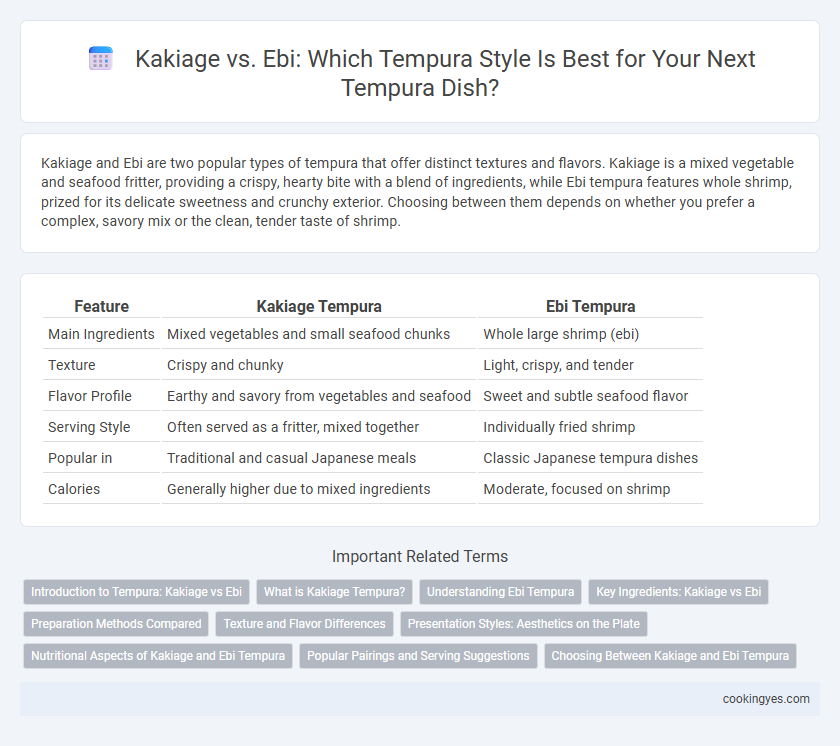Kakiage and Ebi are two popular types of tempura that offer distinct textures and flavors. Kakiage is a mixed vegetable and seafood fritter, providing a crispy, hearty bite with a blend of ingredients, while Ebi tempura features whole shrimp, prized for its delicate sweetness and crunchy exterior. Choosing between them depends on whether you prefer a complex, savory mix or the clean, tender taste of shrimp.
Table of Comparison
| Feature | Kakiage Tempura | Ebi Tempura |
|---|---|---|
| Main Ingredients | Mixed vegetables and small seafood chunks | Whole large shrimp (ebi) |
| Texture | Crispy and chunky | Light, crispy, and tender |
| Flavor Profile | Earthy and savory from vegetables and seafood | Sweet and subtle seafood flavor |
| Serving Style | Often served as a fritter, mixed together | Individually fried shrimp |
| Popular in | Traditional and casual Japanese meals | Classic Japanese tempura dishes |
| Calories | Generally higher due to mixed ingredients | Moderate, focused on shrimp |
Introduction to Tempura: Kakiage vs Ebi
Kakiage and Ebi represent two popular styles of tempura, each offering distinct textures and flavors. Kakiage is a mixed vegetable and seafood fritter that delivers a crispy, hearty bite, while Ebi tempura features whole shrimp with a delicate, crunchy coating. Understanding these variations enhances appreciation for tempura's diverse culinary appeal and regional preferences.
What is Kakiage Tempura?
Kakiage tempura is a type of Japanese tempura made by frying a mixed batter of thinly sliced vegetables and seafood, often including small shrimp or scallops, into a crispy fritter. Unlike ebi tempura, which features whole shrimp battered and fried individually, kakiage combines multiple ingredients into a single, golden-brown cluster. Its unique texture and blend of flavors make kakiage a popular choice for tempura enthusiasts seeking variety beyond the classic ebi tempura.
Understanding Ebi Tempura
Ebi tempura features whole shrimp coated in a light, crispy batter, offering a distinct texture and a sweet, briny flavor that highlights the seafood's freshness. Unlike kakiage, which combines various vegetables and seafood in a mixed fritter, ebi tempura emphasizes the simplicity and purity of the shrimp itself, making it a favorite in traditional tempura dishes. The delicate batter and precise frying technique ensure ebi tempura maintains a crunchy exterior while preserving the tender, juicy interior of the shrimp.
Key Ingredients: Kakiage vs Ebi
Kakiage tempura features a mixture of finely chopped vegetables and seafood, such as onions, carrots, and small shrimp, lightly battered and fried to create a textured medley. In contrast, Ebi tempura highlights whole large shrimp, coated in a light batter that crisps while preserving the shrimp's natural sweetness and firm texture. The key ingredient difference lies in Kakiage's combination of diverse elements versus Ebi's focus on a singular, premium shrimp component.
Preparation Methods Compared
Kakiage tempura consists of mixed vegetables and seafood finely chopped and bound together in a light batter, then deep-fried as a fritter, resulting in a crispy, layered texture. Ebi tempura features whole shrimp, deveined and lightly coated in tempura batter before being fried to achieve a delicate, airy crispiness while preserving the shrimp's natural sweetness. The preparation contrast lies in Kakiage's mixture and shape, offering a savory medley, versus Ebi's focus on individual shrimp maintaining their form and flavor.
Texture and Flavor Differences
Kakiage tempura offers a crispy, mixed-vegetable and seafood texture with a bold, layered flavor profile from its combination of ingredients. Ebi tempura features a tender, succulent shrimp interior enveloped in a light, airy batter that highlights the natural sweetness and umami of the shrimp. Texture-wise, kakiage is crunchier and more varied, while ebi tempura delivers a delicate bite with a focus on the shrimp's fresh, savory taste.
Presentation Styles: Aesthetics on the Plate
Kakiage tempura features a rustic, clustered presentation with mixed vegetables and seafood creating a vibrant, textured mound that showcases a variety of colors and shapes. Ebi tempura offers a sleek, elongated form with golden, crispy shrimp that provides a visually striking contrast against the crisp white plate, emphasizing elegance and simplicity. These distinct plating styles enhance the dining experience by highlighting either the dynamic blend of ingredients in Kakiage or the refined, minimalist beauty of Ebi tempura.
Nutritional Aspects of Kakiage and Ebi Tempura
Kakiage tempura, consisting of mixed vegetables and sometimes small seafood pieces, offers higher fiber and vitamin content due to its diverse ingredients compared to ebi tempura, which features shrimp as the primary source of protein. Ebi tempura provides a lean, low-calorie option rich in omega-3 fatty acids and essential minerals like selenium and iodine. Both types are deep-fried, so they contain similar amounts of fats and calories, but kakiage's vegetable diversity enhances its micronutrient profile.
Popular Pairings and Serving Suggestions
Kakiage tempura combines mixed vegetables and seafood, offering a crispy texture that pairs perfectly with a light dipping sauce or a bowl of hot soba noodles. Ebi tempura, featuring whole shrimp battered and fried, is popularly served with grated daikon and tentsuyu sauce, enhancing its delicate flavor. Both varieties complement rice bowls and tempura udon, making them versatile options in traditional Japanese cuisine.
Choosing Between Kakiage and Ebi Tempura
Choosing between kakiage and ebi tempura depends on texture and flavor preferences; kakiage offers a crispy medley of mixed vegetables and seafood bits, providing a complex and savory bite. Ebi tempura features whole shrimp, delivering a tender, sweet seafood taste with a light, airy batter that highlights its natural flavors. For those seeking variety and crunch, kakiage is ideal, while ebi tempura suits those who prefer a delicate, traditional shrimp experience.
Kakiage vs Ebi for Tempura Infographic

 cookingyes.com
cookingyes.com